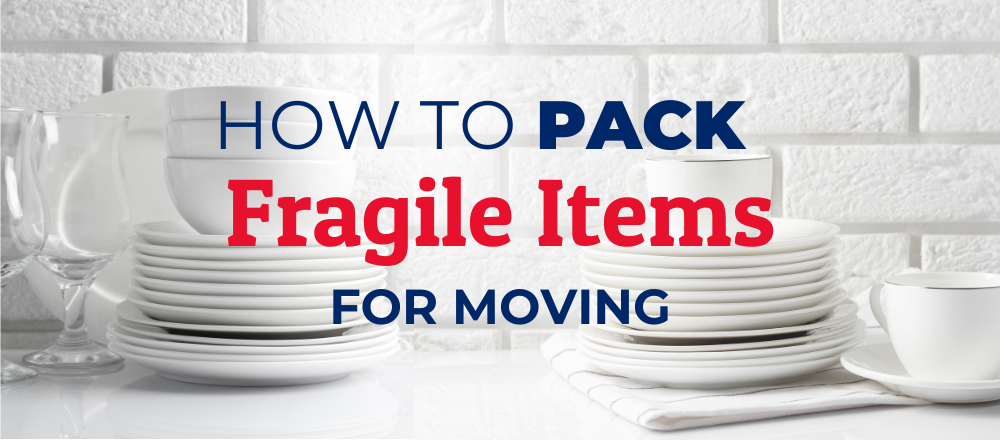

Packing fragile items for your move requires care, strategy, and the right materials. Whether it’s your grandmother’s china, wedding stemware, or a set of handblown glass vases, packing to move is one of the most stressful parts of preparing for a move.
Beyond their monetary value, these fragile items often carry emotional weight—so seeing them arrive in one piece truly matters. The packing process can feel overwhelming, especially if you’re not sure how much bubble wrap or packing paper to use, or how tightly to secure each item. And unfortunately, it’s often the most sentimental pieces that get damaged when improperly packed.
After thousands of moves—and just as many lessons—we’ve developed reliable methods for packing fragile items the right way. From how to wrap each item, to what type of padding works best, we’re here to help you avoid broken glass and heartbreak.
Want your most delicate belongings to survive the back of a moving truck? Here’s exactly how to pack them securely.
Must-Have Packing Materials for Fragile Items
Before you start wrapping, gather the right supplies. The correct packing supplies are the difference between your delicate items arriving intact—or in pieces.
Essential packing materials:
-
Packing paper (you’ll always need more than expected)
-
Bubble wrap
-
Brown packing tape (not duct tape or masking tape)
-
Sturdy cardboard boxes in various sizes
-
Cardboard dividers for glassware
-
Packing peanuts or crumpled paper
-
Cushioning material like kraft paper or towels
Helpful extras:
-
Picture frame boxes or dish packs
-
Chipboard
-
Moving blankets for framed art or mirrors
-
Original boxes for electronics or decorative items
-
Pliable cardboard for irregular shapes
-
News paper
If you’re doing a long-distance move, invest in quality materials—longer transit time increases the risk of breakage.
Double Wrap Each Item for Extra Security
When it comes to packing fragile items, each individual item should be treated with care. Start by wrapping it in packing paper to cover sharp edges or corners. Then layer bubble wrap over the entire piece, sealing it with packing tape.
3-step double-wrapping method:
-
Wrap each fragile object in 1–2 layers of paper.
-
Add bubble wrap as a second layer.
-
Secure with packing tape.
Using this method for every glass, dish, and figurine protects against vibrations in the moving truck and keeps fragile items stable.
Use Cardboard Dividers and Fill Hollow Items
Packing glassware? Always use cardboard dividers or foam inserts in a sturdy cardboard box. These create separate compartments that keep fragile items from knocking into each other. It’s especially helpful for things like wine glasses, champagne flutes, and stemware—which are tall, top-heavy, and prone to tipping inside a box.
Each individual item should be wrapped separately before being placed into a divided space. Dividers not only help with organization but also absorb impact from outside the box and prevent direct contact between items. This kind of structure adds an extra layer of protection and is particularly valuable if your move involves a long drive or multiple stops. Dividers are also reusable and easy to find at most U-Haul or UPS Store locations.
Don’t Waste Space—Fill It Wisely
The more empty space you leave in a box, the more likely your items will shift or collide during transport. That movement—especially in the back of a moving truck—can cause serious damage to even well-wrapped pieces. To avoid this, fill every gap with crumpled paper, soft padding, or packaging peanuts. These cushion your items and act as shock absorbers if the box is dropped or jostled. You can even pack a smaller item in the empty space, just make sure it's well protected.
Avoid using items like clothing or blankets unless you’re out of bubble wrap and other packing materials, as they may shift or compress during the move. For true peace of mind, stick to proven materials like packing paper and bubble wrap. The goal is to fill all empty space to eliminate movement entirely—each fragile item should feel locked into place, fully surrounded by material that will protect it from any angle. This is especially important if you're packing delicate dishes, glass, or smaller decorative fragile items that tend to break easily.
Pro tip: Stuff paper inside the bowl of wine glasses, and add a layer of chipboard on top of everything before sealing the box. This keeps the contents from being crushed by boxes stacked on top.
And remember—heavy items should go on the bottom of the box. This helps with balance and prevents heavier dishes or frames from cracking lighter items beneath them. If your box is already feeling pretty heavy, only add light items or the fill the rest of the space with light items or filler such as packing peanuts or tissue paper.
How To Pack Plates and Picture Frames Safely
Plates should always be packed vertically—like records. This reduces the amount of surface area exposed to pressure. Wrap each one individually, using either bubble wrap or packing paper.
Use dish packs or insert layers of pliable cardboard between plates. You can also repurpose clean bath towels to wrap or layer between heavier items.
For picture frames, use specialty boxes or moving blankets. If you’re short on materials, wrap them tightly in kraft paper and label them clearly. Reinforced corners help protect against pressure during loading.
Why Smaller Boxes Are Smarter
Big boxes may seem efficient, but for fragile items, smaller boxes are often safer. They're easier to carry, less likely to be dropped, and better at minimizing interior shifting. A box that's too large often leads to too much extra space, which increases the risk of fragile items bouncing around inside during transport.
Smaller boxes also help save space in the truck, allowing movers to pack more strategically and reduce unnecessary movement. Plus, using multiple smaller boxes instead of one oversized one distributes weight more evenly, reducing the chance of the box breaking open. If you’re moving delicate items like glass, china, or picture frames, a snug, smaller box is your best bet to ensure each fragile object stays secure.
Seal & Label Everything Clearly
Use extra packing tape—especially across the bottom and top seams of the box. Fragile items can be deceptively heavy, and standard tape might not be enough to hold everything together. Apply a few strips across both directions to reinforce the seal and keep the contents secure. If you're packing heavier items, double-check the strength of the tape and consider reinforcing with an outer box if you're stacking multiple layers inside.
After sealing, be sure to label every side of the box with “FRAGILE” in bold, visible letters. Don’t just write it on the top—boxes get rotated and stacked, and your movers need to know what’s inside at a glance. Use directional arrows and “This Side Up” notes, especially for boxes with glass or top-heavy pieces. Also, listing the contents of each box will help you stay organized and unpack more easily—especially when you’re looking for specific fragile items in a sea of brown boxes.
Hire the Right Help for Fragile Items
A reputable moving company will have trained staff who understand how to pack and handle fragile items. They’ll often bring special boxes, extra packing supplies, and dividers to protect even the most delicate pieces.
Look for a moving company with:
-
A physical address listed on their website
-
A clearly displayed DMV number or license
-
Real (not stock) photos of staff and equipment
-
Transparent contact information
Professional movers should be able to answer your questions without hesitation—and gladly explain their packing process. If something feels off or unclear, trust your gut.
Final Tips Before You Load the Truck
-
Fill every box completely (but not overly full) to prevent collapse.
-
Use dish packs, smaller boxes, and dividers whenever possible.
-
Cover oversized or awkward items with towels, moving blankets, or soft cloths.
-
Avoid using newspaper—it can stain delicate surfaces like fine china and glassware.
-
Keep essentials like medication, jewelry, and personal documents with you during the move.
Doing these small things can make a big difference in keeping your fragile items safe—and make your unpacking process a whole lot easier once you arrive.
Wrapping It Up (with Bubble Wrap, of course)
As you finish packing, take a final walkthrough of your boxes. Make sure each fragile object is well-cushioned with packing paper or bubble wrap, the heavier items are at the bottom, and there’s no extra space left to cause shifting. Double-check your labels, reinforce seams with packing tape, and give any oddly shaped or sentimental items an extra layer of protection—a moving blanket or even a soft towel can go a long way.
And remember: you don’t have to do it all yourself. If packing your most delicate belongings feels overwhelming, our experienced team at 3 Men Movers is here to help. From start to finish, we’ll treat your things with care so everything arrives safely—and you can start settling in with less stress and more peace of mind.